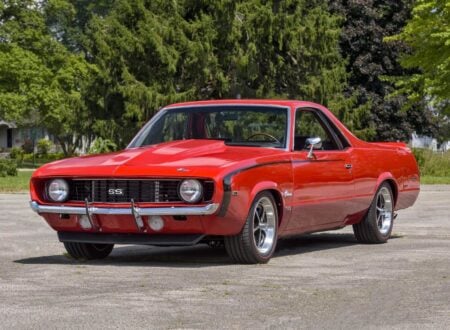Despite the fact that it was only built from 1962 to 1967, the AC Cobra had a profound impact on the motoring world. The surviving examples are worth a king’s ransom and are hotly pursued by collectors and enthusiasts, many of whom enter them in vintage motor racing events.
A Brief History of Carroll Shelby’s AC Cobra
Before Carroll Shelby began building cars he was an accomplished racing driver, who had won at Le Mans, competed in Formula One, and set 16 speed records at the Bonneville salt flats driving a specially prepared Austin-Healey 100S.
His achievements as a driver are all the more impressive due to the fact that he suffered from a serious heart condition, often needing to take nitroglycerine pills before a race. On doctor’s orders he retired from active racing in 1959 shortly after winning the 1959 24 Hours of Le Mans driving an Aston Martin DBR1 with Roy Salvadori.
It was at this race that he first got a close look at the AC Ace, a small British two-seat roadster with a 2 liter engine and a lightweight alloy body. The Ace had finished first in its class at Le Mans (7th over all) and Shelby realized that it could be significantly quicker with a large American V8 under the hood – a lesson he’d learned driving the Allard J2 in 1952 with its 331 cubic inch Cadillac V8.
Once back in the USA Shelby set about finding an engine supplier and writing to AC Cars to see if they were interested in the project. As it happens, they had already increased the size of the engine bay to accommodate the newer 2.6 liter Ford Zephyr engine, and the only major work required to shoehorn in a V8 was to move the steering box to clear the much wider new engine.

AC Cars jumped at the new opportunity, likely seeing it as a way to further promote the brand in the USA, and Carroll Shelby set about finding a suitable V8 for the project. He initially approached Chevrolet but they didn’t want any further competition for the Corvette, so Shelby went to Ford who were more than happy to help provide some competition for the Chevy sports car.
The project started out with the new 3.6 liter Windsor V8, however this engine would change to the 4.3 liter V8 by the time production began. The first 60 production cars were built by AC in England before being shipped to the Shelby workshop in California to have their engines and transmissions fitted.
AC Cobra MkI
The first 75 of the first generation Cobra was built with the 260 cubic inch Ford V8, and the final 51 were fitted with the same 289 cubic inch engine that would later be used in the Mustang. The MkI production run ran from 1962 till 1963, with a total of 126 cars made.
These engines were bolted to the Borg-Warner T-10 transmission, and power was sent back to a Salisbury 4HU differential (also used on the Jaguar XKE). The MkI would also be the lightest production AC Cobra, with a kerb weight of just 2019 lbs.
AC Cobra MkII
The Cobra MkII featured rack and pinion steering and a slightly modified front end, the steering rack was sourced from the MGB and interestingly, the steering column came from the VW Beetle.
All 528 MkII Cobras were fitted with the Ford 289 cubic inch V8, the kerb weight increased slightly to 2315 lbs, and they were built from 1963 till 1965.
AC Cobra MkIII
The MkIII would be the final iteration of the Cobra, it would also be the quickest and most powerful. The plan was to install the new Ford 427 cubic inch engine into the car, but before this could happen the space frame needed to be redesigned using 4 inch steel tube in place of the original 3 inch tubing. Wider fenders were fitted, as was upgraded suspension and brakes all round.
In racing trim, this new 7 liter Cobra was capable of 185 miles per hour, largely thanks to its 2355 lb kerb weight and 485 hp engine. Record keeping wasn’t perfect so actual production numbers aren’t clear, however some of the final MkIII Cobras were fitted with less expensive 428 cubic inch V8s better suited to road use, though not as powerful as their 427 counterpart.
By 1967 orders for the AC Cobra had slowed and it was decided to end production. Although many thought this would be the end of the line for the V8-powered AC roadster the car has lived on with remarkable tenacity. Dozens of companies have developed kit cars based on the design, and there have been a few official continuations produced by both AC Cars and by Shelby American. In fact, it’s possible to buy a new car now from both AC or Shelby.

The Original 1964 AC Cobra 289 MkII Shown Here
The car you see here is one of the popular MkII cars from 1964, it’s fitted with the 289 V8 and was delivered new to Ray Hunt Ford, Florida. The car had a number of owners over the intervening years, and recently underwent a comprehensive restoration to FIA specification by marque expert Mike McCluskey.
The car is now offered in (likely) better than new condition by Fiskens, ready for both road use and vintage competition – if the new owner desires of course. If you’d like to read more about the car or enquire after it, you can click here to visit Fiskens.
Follow Fiskens – Instagram – Facebook – Twitter
















